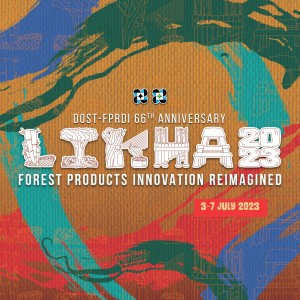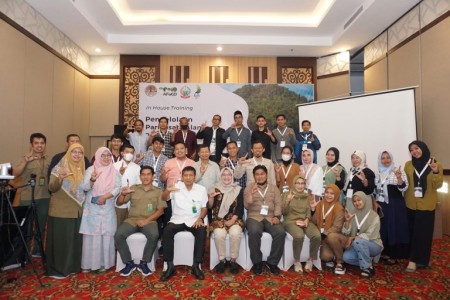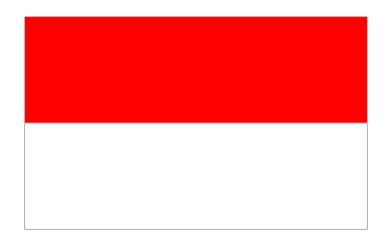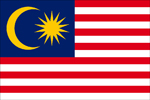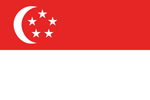Bamboo Utilization Indonesia | 23/07/2023
BAMBOO UTILIZATION
by: Ir. I.M. Sulastiningsih, MSc .
Forestry Engineering and Forest Product Processing Research Center (FEFPProc),Bogor, Indonesia
Current research of bamboo utilization in Indonesia also covers a wide range of products such as ply-bamboo, laminated bamboo, bamboo-zephyr board, bamboo particleboard and bamboo cement board. Research on some properties of bamboo plywood (plybamboo) glued with urea formaldehyde was carried out by Sulastiningsih and Sutigno (1994). The bamboo used was Gigantochloa apus. Ply-bamboo both triplex (3-ply) and multiplex (5-ply) were made from slice bamboo veneer of 1 mm in thickness and 25 mm width. The resin used was urea formaldehyde. The average density of plybamboo were 0,81 g/cm3 and 0,80 g/cm3 for triplex and multiplex, respectively. The bending strength, tensile strength parallel to face grain and compression strength of triplex were lower than that of multiplex. In comparison with plywood properties, some mechanical properties of plybamboo were higher than that of plywood and some of them were lower.
Kasim and Mulyadi (2000) studied the physical and mechanical properties of plybamboo made from three bamboo species. Laboratory scale plybamboo were made from ater bamboo (Gigantochloa atter, Kurz), betung bamboo (Dendrocalamus asper, Backer) and peting bamboo (Gigantochloa verticillata, Munro). The adhesive uses was urea formaldehyde and the amount of glue spread was 170 g/m2. the results showed that bamboo species and position along the bamboo culm significantly affected the physical and mechanical properties of ply-bamboo.
Research on the effect of wood layer on the properties of laminated bamboo boards was carried out by Sulastiningsih et.al.(2005). The laboratory scale (3-layer) laminated bamboo board were made from andong bamboo (Gigantochloa pseudoarundinacea), glued with tannin resorcinol formaldehyde (TRF). Two wood species, mangium (Acacia mangium) and tusam (Pinus merkusii), were used in combination with bamboo to produce laminated bamboo boards. Effect of wood layer on properties of the laminated bamboo boards were examined. Results showed that the wood layer significantly affected the laminated bamboo board properties. The laminated bamboo boards which all layer composed of bamboo had the highest density (0.8 g/cm3) compared to other board which the core layer made of wood (0.7 g/cm3 for mangium and 0.64 g/cm3 for tusam). The laminated bamboo board composed of tusam as the core layer had the lowest dimensional stability compared to other boards. Mechanical properties of the laminated bamboo boards decreased as a result of incorporating wood layer in its composition.
Sidijono, Subyakto and Bambang Subiyanto (2000) studied the manufacture of bamboo- zephyr boards as plywood substitution for concrete – block pallet application. Andong bamboo were cut to 600 mm (face/back) and 400 mm (core) and soaked in the water for 30 days to remove the starch content. Then they were split into 2 – 3 parts and crushed using bamboo – crushing machine to produce zephyr. Outer and inner parts of bamboo zephyr were sanded to remove them of about 2 – 3 mm, resulted in thickness of 4 mm (for face veneer) and 7 mm (for core veneer). The zephyr was dried in dry kiln until reach moisture content of about 7 – 8 %. Dry zephyr was mixed with phenol formaldehyde resin at the amount of 400, 450, and 500 g/m2 and hand formed to make a 3-layer matt with the core layer oriented perpendicularly. The matt was cold press for 10 min at 10 kg/cm2 and hot press at 160°C for 15 min at 10 kg/cm2 to produce 15 by 400 by 600 mm board. After 2 weeks conditioning, the board was tested for bending, shear strength and thickness swelling in accordance with JAS Notification No 516 (1992). The results showed that the bamboo zephyr board with the amount of PF resin of 450 g/m2 gave the best properties. The properties are as follow : MOE = 127,000 kg/cm2, MOR 791 kg/cm2, shear strength = 23.84 kg/cm2 (dry test), 15.86 kg/cm2 (steam treatment test), 12.66 kg/cm2 (cycle boiling test), and thickness swelling = 12.3%. Based on the results, it is possible to manufacture 3-layer bamboo zephyr board using phenol formaldehyde resin as a substitute of plywood for pallet in concrete block production.
Sulastiningsih et al, (1996) studied some properties of bamboo-cement board. Experimental bamboo-cement boards were made from bamboo excelsior obtained from 40 cm bolts of Dendrocalamus asper. The bamboo excelsior were soaked in cold water for 48 hour prior to board manufacture. The bamboo-cement boards mineralized with calcium chloride or calcium hydroxide at 2% concentration and targeted board density of o.6, o.8 and 1 g/cm3 were produced and their properties were tested. Results indicated that type of mineralizer had a significant effect on water absorption and bending strength, whereas the board density had a significant effect on both dimensional and mechanical properties of bamboo-cement board.
Research examining the effects of bamboo-cement ratio and magnesium chloride (MgCl2) content on the properties of bamboo-cement boards was carried out by Sulastiningsih et.al.(2000). Laboratory scale bamboo-cement boards were made from strand-like particles of betung bamboo (Dendrocalamus asper). The effect of two bamboo-cement ratios (1 : 2.4 and 1 : 2.5) and five levels of magnesium chloride (MgCl2) content (0; 2.5; 7.5; and 10% of cement weight) on the properties of bamboo-cement boards were examined. The results showed that the bamboo strands could not be used in their native form for the manufacture of cement-bonded boards; they must be soaked first in cold water for 24 hours prior to board fabrication. The average density of the boards produced was 1.19 g/cm3 . The bamboo-cement ratio significantly affected the thickness swelling, water absorption, modulus of rupture (MOR) and screw holding power of bamboo-cement boards. The MgCl2 content greatly affected all the boards properties except density and linier expansion. The dimensional stability and mechanical properties of bamboo-cement boards increased as the MgCl2 content increased up to a level of 5%. At higher MgCl2 contents board properties decreased slightly. The board produced at a bamboo-cement ratio of 1 : 2.5 and MgCl2 content of 5% had the best dimensional stability and mechanical properties.
The research findings from those bamboo research in Indonesia, however, can not convince and attract the interested stakeholders to develop such bamboo-based industries in Indonesia. This problem is, as a reference, not found in China of which bamboo industry is showing more and more potential. The annual production value is more than US $ 40 billion and its annual export value more than US $ 600 million. There are more new bamboo products in China nowadays, for example, bamboo extracts for beer, beverages, medicine and cosmetics. Other innovative bamboo product developed in recent years include bamboo charcoal, ply-bamboo, bamboo particleboard, bamboo fire-proof ceiling material, and bamboo fiber and its fabric.
Having realized such condition, it is time to describe the real economic and/or ecological worth of bamboo into the forestry development in Indonesia in the years to come, even though it is only on small-scale basis. As soon as the profitable economic worth data available on bamboo, it is expected that the efforts to attract and encourage the communities’ interests to develop bamboo based industries especially laminated bamboo and bamboo panel industries become a reality (Mayana and Subagyo, 2004).
References:
Sudijono, Subyakto & B. Subiyanto.2000 Manufacture of bamboo-zephyr board as plywood substitution for concreate-block pallet application. Proceedings of the Third International Wood Scince Symposium, November 1-2, 2000, Uji Kyoto, Japan.
Sulastiningsih, I.M. 2005. Research on Bamboo Composites in Indonesia. Country Report presented at The International Traning workshop on Small Bamboo Daily Product Processing Technologies and Machines, Zhejiang Province, People’s Republic of China, 6 – 20 September 2005
_____________ and P. Sutigno. 1994. Some properties of bamboo plywood (Plybamboo) glued with urea formaldehyde. Notes of Indonesian Journal of Tropical Agriculture 5(2) : 69 – 72.
_____________ ; Nurwati; S. Murdjoko and S. Kawai. 2000. The effect of bamboo-cement ratio and magnesium chloride (MgCl2) content on the properties of bamboo-cement boards. Proceedings 5th Pasific Rim Bio-Based Composites Symposium, 10 – 13 December 2000. Canbera, Australia.
_____________ ; Nurwati & Adi Santoso. 2005. Effect of wood layer on the properties of laminated bamboo boards. Journal of Forest Products Research 23(1), Bogor, Indonesia.


